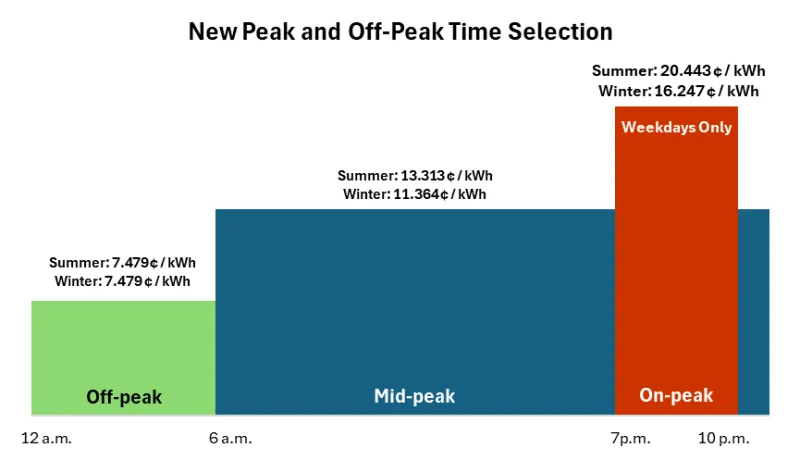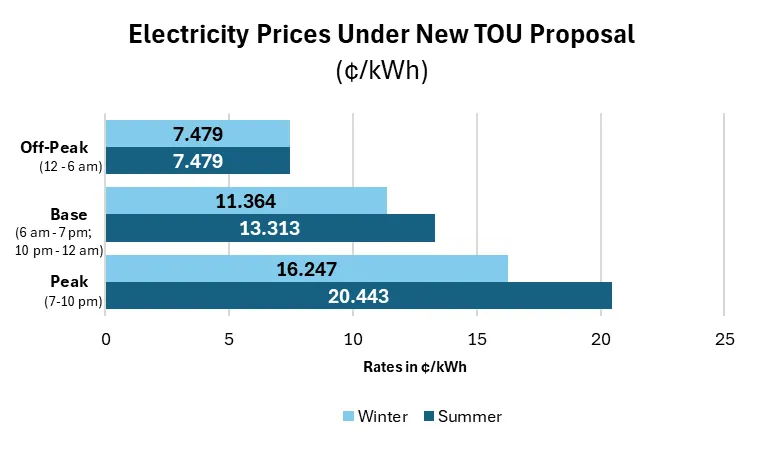Xcel Energy modifies time-of-use rate proposal: lower prices, later peaks, and no more default rollout

In December of 2023, Xcel Energy proposed a default time-of-use (TOU) rate for its entire residential rate class. As captured in our earlier blog post, CUB had several concerns about the company’s originally-filed rate structure. After collecting feedback from its customers and stakeholders like CUB, Xcel updated its proposal. The new rate structure will be offered to residential customers on an optional basis and reduces the variation of energy costs throughout the day and across seasons. Details of Xcel’s new TOU rate are provided below:
Optional Rate Offering
Xcel previously proposed enrolling all residential households into its TOU rates unless they chose to opt-out. Under its new proposal, the TOU rate is offered on a voluntary basis to all residential customers. In explaining its modified approach, Xcel acknowledged that while opt-out rates may lead to higher participation, those enrollment levels could come at the cost of customer satisfaction.
Peak Periods
Under TOU rates, the costs charged to customers are higher during the peak period than they are during off-peak or base hours. The primary reasoning behind this is that more people are using energy during this time, and less low-cost renewable energy is available to serve those needs. As a result, peak energy costs more to produce and often results in higher emissions output.
Xcel’s original proposal included a peak period of 3:00 to 7:00 p.m., an off-peak period of midnight to 6:00 a.m., and a base period for all other hours. This peak period was selected based on system data collected for the company’s 2014 resource plan. Peak hours are determined by looking at the amount of energy generation needed after renewable energy is already accounted for. As a result, the addition of renewable energy resources since 2014 has shifted the net peak later into the day. Starting in 2025, the peak is anticipated to be around 7:00 to 8:00 p.m., but will continue to move later in the day as more renewables are added to the grid. As a result, Xcel has proposed shifting the peak period for its TOU rate to 7:00 to 10:00 p.m. The off-peak period will remain the same.

Price Differentials
In its initial TOU filing, Xcel proposed to charge customers approximately seven times more to use energy during the summer peak period as compared to the off-peak period. Proposed winter costs were approximately five times higher for peak energy use.
In response to concerns expressed by stakeholders and customers, Xcel is now planning to offer TOU rates with much lower price differentials. Now, summer peak energy costs will only be about 2.7 times higher than during off-peak, or around 1.8 times higher than during the base period. These differentials are further reduced in the winter, with on-peak costs being 2.2 and 1.5 times higher than off-peak and base rates, respectively. The proposed pricing (excluding fuel costs) is captured in the table below.

Seasonal Variation
In addition to the high price difference between peak and off-peak rates included in Xcel’s initial filing, there was also a substantial difference in overall costs anticipated during summer and winter. Average residential bills were expected to increase by nearly 18 percent during the summer months, while wintertime bills were set to decrease by approximately 10.6 percent.
CUB expressed concern that these seasonal differences could be difficult for households to budget for, even if the annual amount spent on electricity remained the same. Under Xcel’s new TOU proposal, average residential customers are not expected to experience any difference in their summer or winter bills.
Space Heating Rate
Xcel customers who heat their homes with electricity—such as by using heat pumps or electric baseboard heating—will still be able to access lower space heating rates during the winter. Initially, Xcel proposed a time-varying space heating rate that followed the peak periods of the standard TOU rate. The company is now planning to offer space heating rates to customers at a flat-rate of 6.537¢ / kWh. This lower rate is only available during the winter (Oct - May); households choosing to opt-in to the space heating offering will still pay normal TOU rates during the summer months.
Outreach, Communication, and Rate Comparisons
Although Xcel is no longer planning to implement TOU as the default residential rate, it will still engage with customers to help educate them about the potential benefits associated with time-varying pricing. The company plans to develop specific messaging for communities and customer groups that might benefit or be negatively impacted by the TOU rate to make sure they understand the potential benefits or drawbacks of enrolling in the program.
In addition to these educational efforts, Xcel intends to develop several tools to help customers understand what their bills would be under different rate structures and conditions. The first-proposed tool would provide information about how weather, energy usage, and other factors could impact bills. The second-proposed tool would allow customers to compare rate structures by applying TOU rates to historical household usage. With this tool, customers would be able to identify whether switching to a TOU rate could save them money on their bills, even without adjusting when and how they use energy.
Conclusion
CUB is still in the process of analyzing and evaluating Xcel’s new TOU proposal, but we appreciate the company’s willingness to engage with stakeholders and listen to its customers.
If you receive electricity service from Xcel Energy and are interested in sharing your perspective on the company’s TOU proposal, you can do so by submitting a public comment. An overview about how to submit comments is available on the Public Utilities Commission website. Make sure to reference Docket No. E002/M-23-524 when sharing your thoughts. Your name and information will be published if you choose to file a comment.